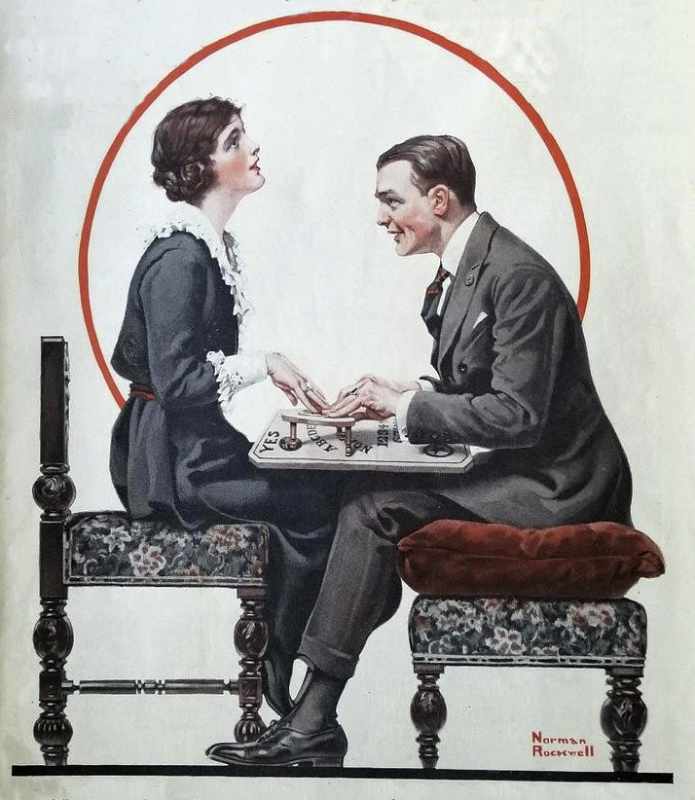The ouija, also known as a spirit board or talking board, is a flat board marked with the letters of the latin alphabet, the numbers 0–9, the words “yes”, “no”, occasionally “hello” and “goodbye”, along with various symbols and graphics. It uses a planchette (small heart-shaped piece of wood or plastic) as a movable indicator to spell out messages during a séance. Participants place their fingers on the planchette, and it is moved about the board to spell out words. “Ouija” is a trademark of Hasbro, but is often used generically to refer to any talking board. One of the first mentions of the automatic writing method used in the ouija board is found in China around 1100 AD, in historical documents of the Song dynasty. The method was known as fuji “planchette writing”. Spiritualists in the United States believed that the dead were able to contact the living and reportedly used a talking board very similar to a modern Ouija board at their camps in the U.S. state of Ohio in 1886 to ostensibly enable faster communication with spirits. Following its commercial introduction by businessman Elijah Bond on 1 July 1890, the Ouija board was regarded as an innocent parlor game unrelated to the occult until American spiritualist Pearl Curran popularized its use as a divining tool during World War I. Aleister Crowley had great admiration for the use of the ouija board and it played a passing role in his magical workings. Paranormal and supernatural beliefs associated with Ouija have been criticized by the scientific community and are characterized as pseudoscience. The action of the board can be most easily explained by unconscious movements of those controlling the pointer, a psychophysiological phenomenon known as the ideomotor effect. Mainstream Christian denominations, including Catholicism, have warned against the use of Ouija boards, holding that they can lead to demonic possession. Occultists, on the other hand, are divided on the issue, with some claiming it can be a tool for positive transformation, while others reiterate the warnings of many Christians and caution “inexperienced users” against it.
| Alias Ouija |
| Real Names/Alt Names N/A |
| Characteristics Paranormal Mysteries, Realism and Victorian Age |
| Creators/Key Contributors ○ |
| First Appearance “Ouija, the Wonderful Talking Board” ad copy (1891) |
| First Publisher ○ |
| Appearance List Literature: “On the Influence of Suggestion in Modifying and directing Muscular Movement, independently of Volition” in Royal Institution of Great Britain (Proceedings) (12 March 1852) by W.B. Carpenter; “Experimental investigation of table-moving” in Journal of the Franklin Institute 56 (1853) by Michael Faraday; Ouija, or Talking-Board (U.S. Patent No. 446,054, issued 10 February 1891; filed 28 May 1890) by Elijah J. Bond, assigned to Charles W. Kennard Novelty Company; Ouija: The Most Interesting Book in the World (1920) by Ralph H. White — rare pamphlet/novel framed as fiction but based on Ouija themes; Ideomotor Action (1981) by Ray Hyman — modern psychological treatment of Ouija motion; Ouija: The Most Dangerous Game (1991) by Stoker Hunt. Podcast: Astonishing Legends: Episode 190-191 Ouija. |
| Sample Read Astonishing Legends: Episode 190 Ouija [YT] |
| Description The ouija, also known as a spirit board or talking board, is a flat board marked with the letters of the latin alphabet, the numbers 0–9, the words “yes”, “no”, occasionally “hello” and “goodbye”, along with various symbols and graphics. It uses a planchette (small heart-shaped piece of wood or plastic) as a movable indicator to spell out messages during a séance. Participants place their fingers on the planchette, and it is moved about the board to spell out words. “Ouija” is a trademark of Hasbro, but is often used generically to refer to any talking board. One of the first mentions of the automatic writing method used in the ouija board is found in China around 1100 AD, in historical documents of the Song dynasty. The method was known as fuji “planchette writing”. Spiritualists in the United States believed that the dead were able to contact the living and reportedly used a talking board very similar to a modern Ouija board at their camps in the U.S. state of Ohio in 1886 to ostensibly enable faster communication with spirits. Following its commercial introduction by businessman Elijah Bond on 1 July 1890, the Ouija board was regarded as an innocent parlor game unrelated to the occult until American spiritualist Pearl Curran popularized its use as a divining tool during World War I. Aleister Crowley had great admiration for the use of the ouija board and it played a passing role in his magical workings. Paranormal and supernatural beliefs associated with Ouija have been criticized by the scientific community and are characterized as pseudoscience. The action of the board can be most easily explained by unconscious movements of those controlling the pointer, a psychophysiological phenomenon known as the ideomotor effect. Mainstream Christian denominations, including Catholicism, have warned against the use of Ouija boards, holding that they can lead to demonic possession. Occultists, on the other hand, are divided on the issue, with some claiming it can be a tool for positive transformation, while others reiterate the warnings of many Christians and caution “inexperienced users” against it. |
| Source Ouija – Wikipedia |

